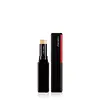What's inside
What's inside
 Key Ingredients
Key Ingredients

 Benefits
Benefits

 Concerns
Concerns

 Ingredients Side-by-side
Ingredients Side-by-side

Water
Skin ConditioningCyclopentasiloxane
EmollientTalc
AbrasiveButylene Glycol
HumectantCetyl PEG/PPG-10/1 Dimethicone
EmulsifyingEthylhexyl Methoxycinnamate
UV AbsorberTrimethylsiloxysilicate
EmollientSilica Silylate
EmollientSodium PCA
HumectantAcrylates/C12-22 Alkyl Methacrylate Copolymer
C12-15 Alkyl Ethylhexanoate
EmollientDimethicone/Vinyl Dimethicone Crosspolymer
Skin ConditioningMagnesium Sulfate
Zinc Stearate
Cosmetic ColorantBis-PEG/PPG-14/14 Dimethicone
EmollientAmodimethicone
Laureth-7
EmulsifyingLecithin
EmollientTribehenin
EmollientMethylparaben
PreservativeTriethoxycaprylylsilane
Disteardimonium Hectorite
StabilisingPhenoxyethanol
PreservativeTrihydroxystearin
Skin ConditioningXanthan Gum
EmulsifyingPropylparaben
PreservativeDimethiconol
EmollientPentylene Glycol
Skin ConditioningTocopheryl Acetate
AntioxidantPropylene Carbonate
SolventHydroxyethylcellulose
Emulsion StabilisingBHT
AntioxidantPentaerythrityl Tetra-Di-T-Butyl Hydroxyhydrocinnamate
AntioxidantCI 77891
Cosmetic ColorantIron Oxides
Water, Cyclopentasiloxane, Talc, Butylene Glycol, Cetyl PEG/PPG-10/1 Dimethicone, Ethylhexyl Methoxycinnamate, Trimethylsiloxysilicate, Silica Silylate, Sodium PCA, Acrylates/C12-22 Alkyl Methacrylate Copolymer, C12-15 Alkyl Ethylhexanoate, Dimethicone/Vinyl Dimethicone Crosspolymer, Magnesium Sulfate, Zinc Stearate, Bis-PEG/PPG-14/14 Dimethicone, Amodimethicone, Laureth-7, Lecithin, Tribehenin, Methylparaben, Triethoxycaprylylsilane, Disteardimonium Hectorite, Phenoxyethanol, Trihydroxystearin, Xanthan Gum, Propylparaben, Dimethiconol, Pentylene Glycol, Tocopheryl Acetate, Propylene Carbonate, Hydroxyethylcellulose, BHT, Pentaerythrityl Tetra-Di-T-Butyl Hydroxyhydrocinnamate, CI 77891, Iron Oxides
Hydrogenated Polydecene
EmollientCI 77891
Cosmetic ColorantCI 77492
Cosmetic ColorantKaolin
AbrasiveMica
Cosmetic ColorantCyclopentasiloxane
EmollientDiphenylsiloxy Phenyl Trimethicone
Skin ConditioningCI 77491
Cosmetic ColorantParaffin
PerfumingLithium Magnesium Sodium Silicate
AbsorbentSorbitan Sesquiisostearate
EmulsifyingPolyethylene
AbrasiveCI 77499
Cosmetic ColorantCI 77120
Cosmetic ColorantGlycerin
HumectantDimethicone/Vinyl Dimethicone Crosspolymer
Skin ConditioningCopernicia Cerifera Wax
Microcrystalline Wax
Emulsion StabilisingWater
Skin ConditioningIsododecane
EmollientPhenoxyethanol
PreservativePEG-10 Dimethicone
Skin ConditioningPolysilicone-2
Hydrogenated Polyisobutene
EmollientAluminum Hydroxide
EmollientSynthetic Fluorphlogopite
Disteardimonium Hectorite
StabilisingEthylene/Propylene/Styrene Copolymer
Simethicone
EmollientButylene Glycol
HumectantPropylene Carbonate
SolventTocopherol
AntioxidantAgar
MaskingNacre Powder
AbrasivePolymethylsilsesquioxane
Polyquaternium-51
Skin ConditioningStearic Acid
CleansingTriethoxysilylethyl Polydimethylsiloxyethyl Dimethicone
Skin ConditioningButylene/Ethylene/Styrene Copolymer
Thymus Serpyllum Extract
Skin ConditioningAlumina
AbrasiveSericin
Skin ConditioningSodium Acetylated Hyaluronate
HumectantBHT
AntioxidantCitric Acid
BufferingPotassium Sorbate
PreservativeHydrogenated Polydecene, CI 77891, CI 77492, Kaolin, Mica, Cyclopentasiloxane, Diphenylsiloxy Phenyl Trimethicone, CI 77491, Paraffin, Lithium Magnesium Sodium Silicate, Sorbitan Sesquiisostearate, Polyethylene, CI 77499, CI 77120, Glycerin, Dimethicone/Vinyl Dimethicone Crosspolymer, Copernicia Cerifera Wax, Microcrystalline Wax, Water, Isododecane, Phenoxyethanol, PEG-10 Dimethicone, Polysilicone-2, Hydrogenated Polyisobutene, Aluminum Hydroxide, Synthetic Fluorphlogopite, Disteardimonium Hectorite, Ethylene/Propylene/Styrene Copolymer, Simethicone, Butylene Glycol, Propylene Carbonate, Tocopherol, Agar, Nacre Powder, Polymethylsilsesquioxane, Polyquaternium-51, Stearic Acid, Triethoxysilylethyl Polydimethylsiloxyethyl Dimethicone, Butylene/Ethylene/Styrene Copolymer, Thymus Serpyllum Extract, Alumina, Sericin, Sodium Acetylated Hyaluronate, BHT, Citric Acid, Potassium Sorbate
Ingredients Explained
These ingredients are found in both products.
Ingredients higher up in an ingredient list are typically present in a larger amount.
BHT is a synthetic antioxidant and preservative.
As an antioxidant, it helps your body fight off free-radicals. Free-radicals are molecules that may damage your skin cells.
As a preservative, it is used to stabilize products and prevent them from degrading. Specifically, BHT prevents degradation from oxidation.
The concerns related to BHT come from oral studies; this ingredient is currently allowed for use by both the FDA and EU.
However, it was recently restricted for use in the UK as of April 2024.
Learn more about BHTButylene Glycol (or BG) is used within cosmetic products for a few different reasons:
Overall, Butylene Glycol is a safe and well-rounded ingredient that works well with other ingredients.
Though this ingredient works well with most skin types, some people with sensitive skin may experience a reaction such as allergic rashes, closed comedones, or itchiness.
Learn more about Butylene GlycolCi 77891 is a white pigment from Titanium dioxide. It is naturally found in minerals such as rutile and ilmenite.
It's main function is to add a white color to cosmetics. It can also be mixed with other colors to create different shades.
Ci 77891 is commonly found in sunscreens due to its ability to block UV rays.
Learn more about CI 77891Cyclopentasiloxane, or D5, is a silicone used to improve texture of products and trap moisture.
D5 is considered lightweight and volatile. Volatile means it evaporates quickly after application. Once evaporated, D5 leaves a thin barrier that helps keep skin hydrated.
It is also an emollient. Emollients help soften the skin and prevent water loss. Silicones create a silky texture in products. D5 helps other ingredients become more spreadable.
Studies show D5 is safe to use in skincare products. We recommend speaking with a skincare professional if you have concerns.
Learn more about CyclopentasiloxaneThis ingredient is a silicone used to improve the texture of products and absorb oil. It does not get absorbed into the skin.
Like other silicones, Dimethicone/Vinyl Dimethicone Crosspolymer helps condition the skin by creating a barrier. In this sense, it can act as an emollient and trap moisture in.
This ingredient is a type of elastomer.
Learn more about Dimethicone/Vinyl Dimethicone CrosspolymerDisteardimonium Hectorite comes from the clay mineral named hectorite. It is used to add thickness to a product.
It can also help stabilize a product by helping to disperse other ingredients.
Hectorite is a rare, white clay mineral.
Learn more about Disteardimonium HectoritePhenoxyethanol is a preservative that has germicide, antimicrobial, and aromatic properties. Studies show that phenoxyethanol can prevent microbial growth. By itself, it has a scent that is similar to that of a rose.
It's often used in formulations along with Caprylyl Glycol to preserve the shelf life of products.
This ingredient is a solvent. It helps dissolve active ingredients and alter the texture of products.
Propylene Carbonate is commonly used in makeup and with clay, such as montmorillonite or bentonite.
Studies show this ingredient to be safe for cosmetics. When it is undiluted, it can cause skin irritation. (It is always diluted in skincare and makeup). This ingredient is water-soluble.
Propylene Carbonate is created from propylene glycol and carbonic acid.
Learn more about Propylene CarbonateWater. It's the most common cosmetic ingredient of all. You'll usually see it at the top of ingredient lists, meaning that it makes up the largest part of the product.
So why is it so popular? Water most often acts as a solvent - this means that it helps dissolve other ingredients into the formulation.
You'll also recognize water as that liquid we all need to stay alive. If you see this, drink a glass of water. Stay hydrated!
Learn more about Water